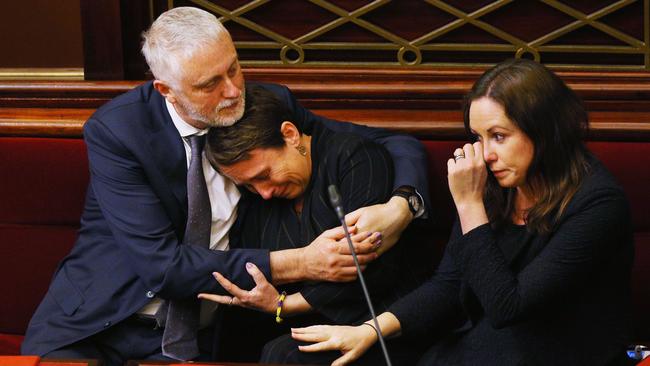Democracy may be messy but the alternative is chaos
In Canada I saw the perfect proof of why Australia should steer clear of a bill of rights of any kind.

Should it be the Australian people? Or a handful of judges empowered by a bill or a charter of rights and egged on by lawyers in search of work and other impatient activists?
The activists, including legal academic George Williams, are trying to harness new recruits in the media to an old cause. Riding the slipstream of the media’s Right to Know campaign, they claim the only way to truly protect the media’s ability to report matters of public interest is with a complete legal overhaul. Simple tinkering will not do, they say.
It’s all very curious. These people weren’t free-speech fans when it came to repealing section 18C of the Racial Discrimination Act. Nor are they the least bit interested in a religious freedom law. But the Right to Know campaign? That, apparently, demands a new law to protect freedom.
Except it’s not new. They have been flogging this same old dead horse for years and it is deeply anti-democratic. Even a charter of rights passed by our federal parliament as a mere legislative instrument is a ruse, a way to warm us up for the finale, a real lawyers’ picnic: a constitutionally entrenched charter.
If that all sounds rather dramatic, while in Canada these past four weeks I saw the perfect proof of why Amnesty is wrong and why we should steer clear of any kind of charter of rights. It involves one of the most fundamental rights imaginable: a person’s right to decide when to end their life.
In Canada the courts call the shots about this issue. In Australia, we, the people, decide these laws. And you don’t need a legal degree, let alone a doctorate in constitutional law, to work out which is more democratic and which model carries more legitimacy with the people.
Recall the history of assisted dying laws in Australia. The Northern Territory Legislative Assembly passed the world’s first law to legalise euthanasia in May 1995. Then, in March 1997, the federal Senate passed another law, rendering that law invalid.
It was a highly contested issue. More than 20 years later two Australian states, Western Australia and Victoria, have passed assisted dying laws because our elected representatives have undertaken the messy, long and laborious process known as democracy.
It involves considering, investigating, discussing, calling for submissions from lay folk as well as medical experts, drafting, deliberating over changes and, finally, passing these laws.
As Western Australia’s Health Minister Roger Cook said after the Voluntary Assisted Dying Bill passed in the state’s parliament last year: “We are at the end of a very long process, a momentous process for the West Australian parliament and West Australian public.”
Two years earlier Victoria’s parliament passed a similar law after an equally gruelling process.
Meanwhile, democracy led the NSW parliament to consider the same issue and reject it in 2017.
The ACT government has responded to, and largely agreed to, an end of life report, even though it lacks the power to enact such laws. Queensland’s parliament undertook an inquiry in 2018, extending it until March this year. South Australian Premier Steven Marshall also has committed that state’s parliament to an inquiry, with public submissions concluding last year.
Contrast our long, carefully considered and, yes, messy but very democratic path to assisted dying laws with Canada’s route.
There, a lovely sounding charter of rights and freedoms has turned a vibrant people’s democracy into a guided democracy with the Supreme Court of Canada playing the part of Lee Kuan Yew. In this and other major policy areas the real decision-maker in Canada is a judicial aristocracy, an unelected, unaccountable and unsackable body that treats elected parliaments with disdain, if not contempt.
It was not always thus. Canada, like Australian states and territories, historically followed a centuries-old legal principle embodied in section 241 of Canada’s Criminal Code. That law, enacted by parliament, provided that assisting someone to commit suicide was a crime. Indeed, even Canada’s Supreme Court, in a 1993 decision called Rodriguez, upheld that position despite the addition of the charter of rights and freedoms to the Canadian Constitution in 1982.
But then fashions changed. By 2015 the Supreme Court, in a case called Carter, decided the charter of rights and freedoms did, indeed, confer a right to assisted suicide for those with a “grievous and irremediable medical condition, including an illness, disease or disability, that causes enduring suffering that is intolerable to the individual in the circumstances of his or her condition”.
How did they decide? It was nothing short of a court assuming the role of philosopher king.
Somewhat condescendingly the Supreme Court gave the Canadian parliament 12 months to draft a law complying with the court’s ruling.
The government had to go to court to grovel for an extension but eventually parliament did what the court ordered it to do.
Or did it? Last September a single judge in a lower court, Justice Christine Baudouin of the Quebec Superior Court, marked parliament’s exam paper with F for fail. The judge decided that it breached Canada’s charter for the parliament to insert a limitation requiring that death be “reasonably foreseeable” before a patient was eligible for voluntary assisted death.
Activists cheered Baudouin. And they are rubbing their hands together in anticipation of further judicial activism over two other aspects of the parliament’s law on assisted dying.
Parliament has prohibited minors from accessing assisted dying and also prohibited “advance directives”, preferring to demand that consent be given for assisted dying in the moments right before death.
If activists can find a few agreeable judges they can override the will of the people here, too.
Note that a single judge with no special expertise in relevant medical, social, or economic policy areas has widened the boundaries of a deeply complicated issue without access to all the analytic, expert and research resources of parliament, or the benefit of full, public consultation. And neither should courts have access to these resources. After all, they are not meant to be politicians.
Yet Canadian courts run the country in key areas because they can. And parliaments must dance to their tune.
Apologists for the Canadian charter will point to what is called the “notwithstanding” clause as rescuing parliamentary sovereignty. While it is true there is a theoretical ability for parliaments to override the courts, they can do so only for a limited period and some critical charter rights cannot be overridden, even temporarily. Proof that this is a useless fetter on the court’s ability to tell the parliament what to do is that the federal parliament has never once tried to use the “notwithstanding” clause.
Making all this worse, when the Supreme Court of Canada in the Carter case overruled its own Rodriguez decision it made stare decisis (the legal principle of determining points in litigation according to precedent) a dead letter and effectively invited lower courts to ignore legal precedents and get in on the lawmaking act.
Canada’s key social policies are hostage not merely to the latest fads sweeping the Supreme Court but also the policy fashions of judges in myriad lower courts.
And that is the other inherent flaw in the case for an Australian bill of rights to protect our basic freedoms. Like Williams, charter fans claim it is the only way to deal with issues that parliament squibs.
What the advocates and activists won’t mention is that they are simply impatient with old-fashioned democratic processes and often deeply scornful of its results.
A bill of rights is the undemocratic fast-track to laws they prefer. It gives judges a set of human rights laws that are vaguely drafted, inviting them to decide big policy issues and allowing them to inject their personal biases into judgments.
There is a reason the Americans call it an end-run around democracy. It’s how to run right past democratic processes without getting bogged down by the people or the politicians who represent them.
This battle between parliament and the courts is not confined to Canada. This week, New Zealand Prime Minister Jacinda Ardern backed euthanasia laws. If passed by the parliament, it will be only a matter of time before a few judges in that country use the New Zealand bill of rights to meddle in this controversial issue.
A fortnight ago, British Prime Minister Boris Johnson said he was concerned that judicial review had become a way of “conducting politics by another means”. While judicial review is, indeed, a vital cornerstone of our legal system and a fundamental protection for the citizen against an over-mighty government, there is a pretty strong argument it has gone too far.
Judicial review was intended to prevent abuses of process and patently untenable decisions. Today, spurred by like-minded activists who head to court, judges increasingly are using their unelected pulpits to implement their personal policy preferences over those of elected and accountable politicians.
In Australia, we should never take for granted that Australian laws are still made by parliaments elected by, and accountable to, Australian voters.




The rights activists could not be more wrong. The latest bid for an Australian charter or bill of rights launched this week by Amnesty International fails at the most fundamental hurdle: the one about who should make laws in a democracy.